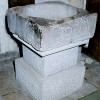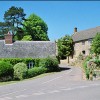Had you been able, 140 million years ago, to stand where Studland, Worth Matravers or anywhere else in Purpeck now are, your surroundings would have been as terrifying as they were breathtakingly primeval. You would have been thrown back to the age of the Dinosaurs, but at a point approximately half-way along in their reign on earth, with almost as long again before the catastrophe in which they perished.
By the end of the much-publicised Jurassic period, south east Dorset was covered by a swampy lake in which the sediments now forming the Purbeck beds were deposited. Here the water margin was frequented by the great reptiles of the day, who left their multi-ton imprints in the soft mud, a substratum which periodically dried out, setting footfalls in what today is the solid rock of the Purbeck cliffs and promontories.
Because of this unfortunate accident of nature in remote antiquity, Purbeck today is not just the centre of a long tradition of aggregate extraction. The course of nature has made it simply one of the world’s premier dinosaur sites. It is a treasure house of prehistory, but one more noted for the traces of these monsters than for their bones. The Purbeck hills have yielded more sets of saurian footprints than any other area of Britain. And the bones which have been found – usually washed up by the sea – hint powerfully at the presence of a dinosaur graveyard somewhere beneath Swanage Bay.
Through excavation and quarrying activity however, it has become apparent that one formation above all others has preserved the great majority of the saurian traces discovered in the Purbeck Series. This is a scorious, pink sandy limestone packed with casts of numerous spire-shelled snails, called the Roach (or Pink) Bed. This bed lies only a few feet below the surface and is fissured horizontally and vertically. In 1962 Geologist J.B. Delair had noted the high frequency of reptilian prints in this bed, but such traces from any other Purbeck beds would not be proved until 1965.
Delair noted that the prints occurred along the bedding. Other clues suggested the saurians were in shallow water just deep enough to keep their tails buoyed up as they waded in deeper, for there are sets of tracks starting well-defined, but which become less distinct with immersion.
In all instances the prints show action: the reptiles were not simply standing or grazing passively. Some appeared to be running or changing direction. Six-inch prints exposed in a quarry near Acton have been attributed to a creature named Purbeckopus pentactylus . Two prints facing away from each other at 90 degrees were discovered in 1936 and another set forming an almost complete circle on the rock bed has also been found.
Delair noted, in a quarry between Worth Matravers and Acton, prints orientated in all directions around a saucer-like depression on a bedding plane. Although several dozen saurian prints in all have been found in Purbeck, barely a handful has been saved for posterity, and most of these have been erased or partly obscured by weather conditions. In 1961 at Herston a fine set of double tracks saw the light of day when E.W. Shuttle re-opened Mutton Hole Quarry. There were 26 prints, and a further trail was discovered here in 1962 which attracted much more attention from the scientific community. The prints were interpreted as those of a Megalosaurus, but no attempt was made to preserve them. The Natural History Unit of the British Museum excavated a further 70 prints from an undamaged section at Mutton Hole.
A quarry at Queensground, Lytchett Matravers, revealed prints of Tri-dactyls, one of which came not from the Roach Bed but a freestone bed four feet lower. This made it the first saurian footprint ever to be found in a bed other than Roach.
Upon the great extinction and geographical change which ushered in the Tertiary era, the dinosaur remains were engulfed in torrents of water bearing sediments which buried their carcasses and traces. But Purbeck’s fossil record bears witness to the next great evolutionary leap – the emergence of the mammals. One of the earliest deposits of mammalian remains is in the cliffs at Durlston Bay. The remains are disarticulated bones and teeth of some of the earliest marsupials, heralding the scion of evolution that, 50 million years later, would result in the appearance of ourselves.



